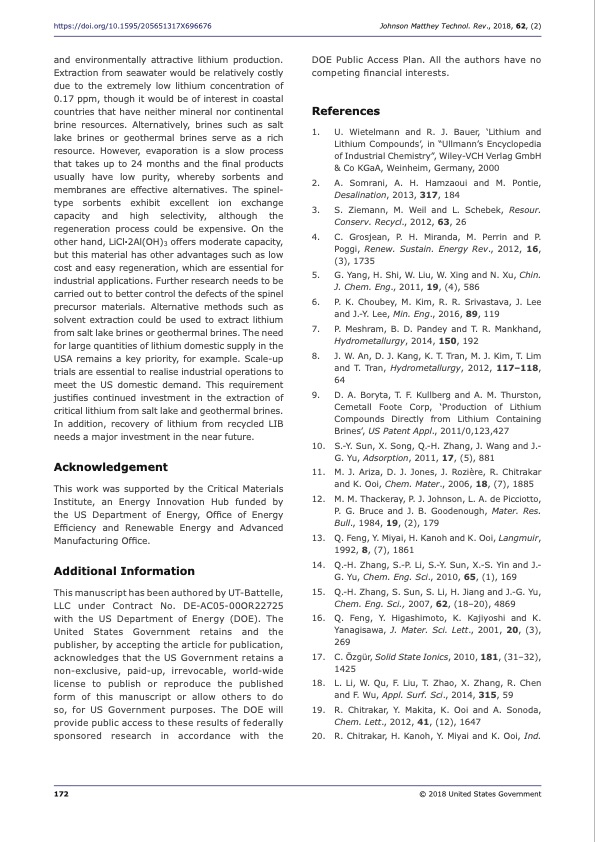
PDF Publication Title:
Text from PDF Page: 012
https://doi.org/10.1595/205651317X696676 and environmentally attractive lithium production. Extraction from seawater would be relatively costly due to the extremely low lithium concentration of 0.17 ppm, though it would be of interest in coastal countries that have neither mineral nor continental brine resources. Alternatively, brines such as salt lake brines or geothermal brines serve as a rich resource. However, evaporation is a slow process that takes up to 24 months and the final products usually have low purity, whereby sorbents and membranes are effective alternatives. The spinel- type sorbents exhibit excellent ion exchange capacity and high selectivity, although the regeneration process could be expensive. On the other hand, LiCl·2Al(OH)3 offers moderate capacity, but this material has other advantages such as low cost and easy regeneration, which are essential for industrial applications. Further research needs to be carried out to better control the defects of the spinel precursor materials. Alternative methods such as solvent extraction could be used to extract lithium from salt lake brines or geothermal brines. The need for large quantities of lithium domestic supply in the USA remains a key priority, for example. Scale-up trials are essential to realise industrial operations to meet the US domestic demand. This requirement justifies continued investment in the extraction of critical lithium from salt lake and geothermal brines. In addition, recovery of lithium from recycled LIB needs a major investment in the near future. Acknowledgement This work was supported by the Critical Materials Institute, an Energy Innovation Hub funded by the US Department of Energy, Office of Energy Efficiency and Renewable Energy and Advanced Manufacturing Office. Additional Information This manuscript has been authored by UT-Battelle, LLC under Contract No. DE-AC05-00OR22725 with the US Department of Energy (DOE). The United States Government retains and the publisher, by accepting the article for publication, acknowledges that the US Government retains a non-exclusive, paid-up, irrevocable, world-wide license to publish or reproduce the published form of this manuscript or allow others to do so, for US Government purposes. The DOE will provide public access to these results of federally sponsored research in accordance with the Johnson Matthey Technol. Rev., 2018, 62, (2) DOE Public Access Plan. All the authors have no competing financial interests. References 1. 2. 3. 4. 5. 6. 7. 8. 9. 10. 11. 12. 13. 14. 15. 16. 17. 18. 19. 20. U. Wietelmann and R. J. Bauer, ‘Lithium and Lithium Compounds’, in “Ullmann’s Encyclopedia of Industrial Chemistry”, Wiley-VCH Verlag GmbH & Co KGaA, Weinheim, Germany, 2000 A. Somrani, A. H. Hamzaoui and M. Pontie, Desalination, 2013, 317, 184 S. Ziemann, M. Weil and L. Schebek, Resour. Conserv. Recycl., 2012, 63, 26 C. Grosjean, P. H. Miranda, M. Perrin and P. Poggi, Renew. Sustain. Energy Rev., 2012, 16, (3), 1735 G. Yang, H. Shi, W. Liu, W. Xing and N. Xu, Chin. J. Chem. Eng., 2011, 19, (4), 586 P. K. Choubey, M. Kim, R. R. Srivastava, J. Lee and J.-Y. Lee, Min. Eng., 2016, 89, 119 P. Meshram, B. D. Pandey and T. R. Mankhand, Hydrometallurgy, 2014, 150, 192 J.W.An,D.J.Kang,K.T.Tran,M.J.Kim,T.Lim and T. Tran, Hydrometallurgy, 2012, 117–118, 64 D. A. Boryta, T. F. Kullberg and A. M. Thurston, Cemetall Foote Corp, ‘Production of Lithium Compounds Directly from Lithium Containing Brines’, US Patent Appl., 2011/0,123,427 S.-Y. Sun, X. Song, Q.-H. Zhang, J. Wang and J. G. Yu, Adsorption, 2011, 17, (5), 881 M. J. Ariza, D. J. Jones, J. Rozière, R. Chitrakar and K. Ooi, Chem. Mater., 2006, 18, (7), 1885 M. M. Thackeray, P. J. Johnson, L. A. de Picciotto, P. G. Bruce and J. B. Goodenough, Mater. Res. Bull., 1984, 19, (2), 179 Q. Feng, Y. Miyai, H. Kanoh and K. Ooi, Langmuir, 1992, 8, (7), 1861 Q.-H. Zhang, S.-P. Li, S.-Y. Sun, X.-S. Yin and J. G. Yu, Chem. Eng. Sci., 2010, 65, (1), 169 Q.-H. Zhang, S. Sun, S. Li, H. Jiang and J.-G. Yu, Chem. Eng. Sci., 2007, 62, (18–20), 4869 Q. Feng, Y. Higashimoto, K. Kajiyoshi and K. Yanagisawa, J. Mater. Sci. Lett., 2001, 20, (3), 269 C. Özgür, Solid State Ionics, 2010, 181, (31–32), 1425 L. Li, W. Qu, F. Liu, T. Zhao, X. Zhang, R. Chen and F. Wu, Appl. Surf. Sci., 2014, 315, 59 R. Chitrakar, Y. Makita, K. Ooi and A. Sonoda, Chem. Lett., 2012, 41, (12), 1647 R. Chitrakar, H. Kanoh, Y. Miyai and K. Ooi, Ind. 172 © 2018 United States GovernmentPDF Image | Lithium Recovery from Aqueous Resources

PDF Search Title:
Lithium Recovery from Aqueous ResourcesOriginal File Name Searched:
b8befda967a8ccf19190203d3b5aeae0673f.pdfDIY PDF Search: Google It | Yahoo | Bing
Product and Development Focus for Infinity Turbine
ORC Waste Heat Turbine and ORC System Build Plans: All turbine plans are $10,000 each. This allows you to build a system and then consider licensing for production after you have completed and tested a unit.Redox Flow Battery Technology: With the advent of the new USA tax credits for producing and selling batteries ($35/kW) we are focussing on a simple flow battery using shipping containers as the modular electrolyte storage units with tax credits up to $140,000 per system. Our main focus is on the salt battery. This battery can be used for both thermal and electrical storage applications. We call it the Cogeneration Battery or Cogen Battery. One project is converting salt (brine) based water conditioners to simultaneously produce power. In addition, there are many opportunities to extract Lithium from brine (salt lakes, groundwater, and producer water).Salt water or brine are huge sources for lithium. Most of the worlds lithium is acquired from a brine source. It's even in seawater in a low concentration. Brine is also a byproduct of huge powerplants, which can now use that as an electrolyte and a huge flow battery (which allows storage at the source).We welcome any business and equipment inquiries, as well as licensing our turbines for manufacturing.| CONTACT TEL: 608-238-6001 Email: greg@infinityturbine.com | RSS | AMP |